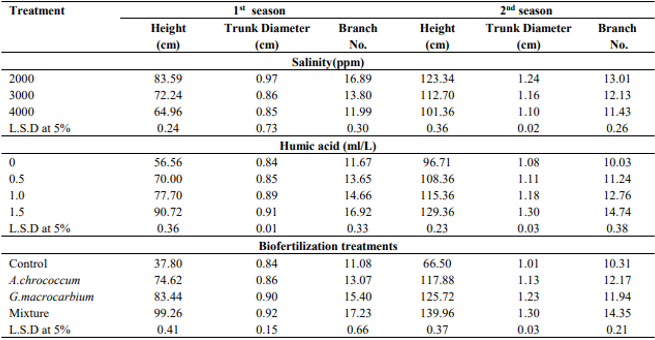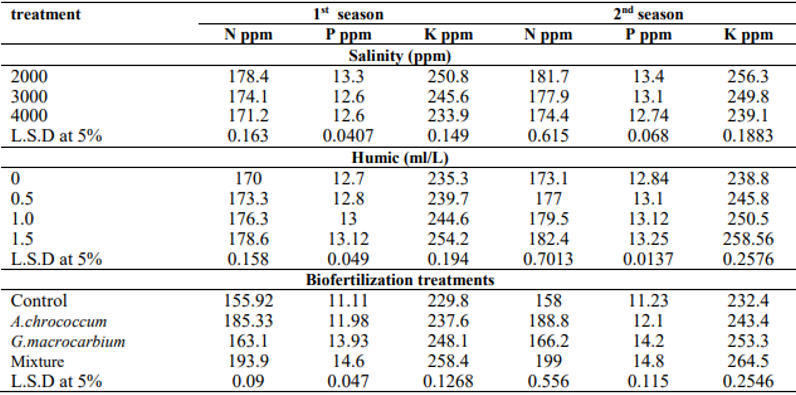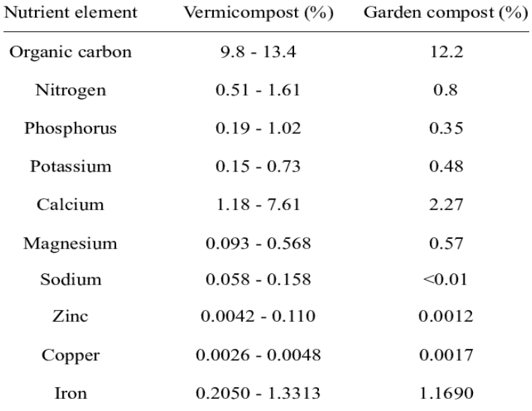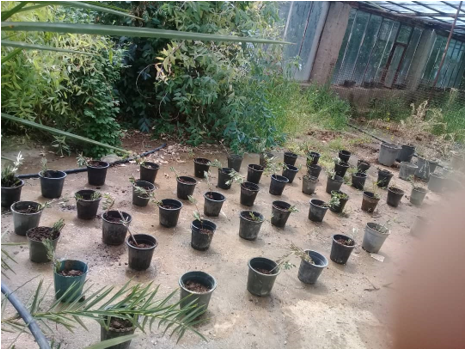Research Article
Volume 4 Issue 1 - 2022
Investigation of the Effect of Biofertilizer Application on Nutrient Uptake and Reduction of Salinity Stress, and Yield Components in Pharmaceutical Olive Tree
Assistant Professor, Semnan University - Iran
*Corresponding Author: Hamid kheyrodin, Assistant Professor, Semnan University - Iran.
Received: September 14, 2022; Published: September 29, 2022
Abstract
Olive plant is one of the most important medicinal plants in the world. The oleuropein contained in the leaves and the resulting Oleacein of the drying process are responsible for the blood pressure lowering properties. In animal experiments with olive leaf extract and some iridoids removed from it, confirmed the blood pressure lowering properties, clinical studies however have not been conducted, so the efficacy has as yet not been established. See also "traditional use". Olive oil is used pharmaceutically as an extraction agent for the production of oil resins (such as cayenne pepper oleoresin) and in its purified form for the manufacture of parenteral preparations (injections). The aim of this experiment was to investigate the effect of biofertilizer application and treatments of different salinity levels on yield, yield components and growth indices of olive medicinal plant and its effect on the quality of olive oil and leaf extract in canning and kerneling stages. The experiment is carried out in the form of split plots in the form of complete split-split plot block design with three replications in Semnan city located in Semnan province. The main factor includes two levels of fertile phosphate biofertilizer and three levels of vermicompost biofertilizer (0, 1000, 1500) as a sub-factor for each tree and four different levels of sodium chloride (zero, 40, 80, and 120 mM) as Sub-factor for all 24 treatments of each block "A total of" 72 treatments "are evaluated in the research station of the Faculty of Desert Studies.In this research we concluded that Salinity reduces the fruit weight and oil content, plant height , biological yield root production, while decrease the moisture and vermicompost content. We concluded that total phenol content in the olive oil is not affected by moderate NaCl salinity, but affected by biofertilizer treatments. We show that IBA treatments increased the number of roots per cutting in comparison with the control, but decreased the length of the roots of cultivar.
Keywords: Olive medical plant; Biofertilizer; Sodium chloride tolerance; Vermicompost
Introduction
The cultivated olive (Olea europaea L.) belongs to family Oleaceae The olive, botanical name Olea europaea, meaning 'European olive', is a species of small tree or shrub in the family Oleaceae, found traditionally in the Mediterranean Basin. Due to the semi-arid and relatively saline climatic conditions in olive cultivated areas in the country, increasing salinity resistance in this plant is important. To achieve this goal, recognizing salinity tolerant genotypes and understanding the mechanisms of salinity tolerance in olive plants is essential.
Olive is a subtropical plant and is found in areas where there is a risk of severe frosts. If there is no winter, it is planted. The olive tree is always green and its leaves fall every 2 to 4 years, while all leafy year’s young ones appear on the branch.
Olive blossoms are usually later than. The flowers of other fruit trees bloom. Flowers are clusters and what is each cluster of clusters has been formed. The color of the flowers is white shellfish with four petals and four. The sepals and the female are two garments that, of course only one egg is inoculated and the other is aborted. The ovary has a short cream it is white Tomaino et al. 2005.
There are two types of flowers. Whole flowers that have male and female organs and flowers incomplete ones that have only male limbs. The number of flowers is extremely large and if Turning 1 to 3% of flowers into fruit will be a suitable and economical yield. Talqih it is done by wind and insects. Incompatibility of pollen with female is one of the most important Other known factors are fertility in olives. Flower buds next to each leaf in olive There are donors. Yen buds in season currents arise and grow in season the next sprouts. Each inflorescence includes 15 to 30 flowers, this number is different the cultivar and agricultural conditions of that year depend. If an inflorescence appears next to all the leaves, each branch has several production potentials will have a hundred goals. But only 5% of these flowers turn into fruit
The olive tree is able to adapt to different environmental conditions. This tree needs mild climates with less hot summers and cold winters.
Also olives need cold for proper fruiting, but if the temperature is less than 10 degrees when it reaches Celsius, it is damaged. Olive as a drought tolerant plant species it is known and can withstand water stresses. The minimum water requirement of olives in 2000 is 2000 cubic meters per hectare. More on this Water, during the flowering period and seed formation in late spring and summer when the size of the fruit Increases, is required. Olives it can be found in poor soils and soils a rock grows on the edge of the hills, but the best olives are made from trees cultivated in deep soils.
Olive Cultivar
From the point of view of modern growers, the variety of known olives is very large. In Italy alone there are at least 300 species, but a small number of them have grown to a large extent They can. The main Italian species are Frantoio, Leccino and Carolea. None of them can not be equated with ancient descriptions, although it is not unlikely that some species. The thinnest leaves that are most noticeable are of Licinian descent. Trees the broadleaves of Spain produce large fruits, but their pods have a relatively bitter taste. Their oil quality is poorer.
From the point of view of modern growers, the variety of known olives is very large. In Italy alone there are at least 300 species, but a small number of them have grown to a large extent They can. The main Italian species are Frantoio, Leccino and Carolea. None of them can not be equated with ancient descriptions, although it is not unlikely that some species. The thinnest leaves that are most noticeable are of Licinian descent. Trees the broadleaves of Spain produce large fruits, but their pods have a relatively bitter taste. Their oil quality is poorer.
Tarom Olive Research Station is the most important olive research station in Iran. In this station, about 60 cultivars and 200 different genotypes from Iran and different regions of the world It has been collected that it is in fact the largest genetic reserve of olives in Iran and the Middle East considered.
In general, the most important olive cultivars in the country are divided into two categories: domestic and foreign cultivars. They are divided. Domestic cultivars including yellow, oily, snake, snail, apricot, fish, Dezful and foreign cultivars that are mostly native to Spain, Greece, France and Italy and Syria can be cultivated Conservalia, Valenolia, Sevilla, Arbkin, Lechino, Abu Satel, Jellat, Kronaiki, Blaidi, and Amygdalola
Study site and soil analysis methods
Plant material
150 semi- hardwood stems cuttings of olive cultivar prepared from middle portion of vigorous 1-year-old shoots. Cuttings had about a 0.8 to 0.5 cm diameter, 20-30 cm length with six leaves. Cuttings were prepared in Final march and April springtime season.
Plant material
150 semi- hardwood stems cuttings of olive cultivar prepared from middle portion of vigorous 1-year-old shoots. Cuttings had about a 0.8 to 0.5 cm diameter, 20-30 cm length with six leaves. Cuttings were prepared in Final march and April springtime season.
The experiment is carried out in the form of split plots in the form of complete split-split plot block design with three replications (figure 1). The effect of fertile vermicompost and phosphate fertilizer treatments on traits such as leaf area, fruit formation, fruit weight and fruit oil percentage will be measured by method of Casale and Simonetti 2014. The results of the measured test data are performed by statistical analysis (ANOVA) by SPSS method and comparison of means by Duncan method 2010 and Basiri 1370.
The effect of biofertilizer treatments on the activity of nitrate reductase enzyme in leaves and roots is also investigated by Stewart et al. 1972. Also, the volume of olive growth components such as roots is recorded by placing all the roots in a distilled water solution in a 1000 ml graduated container for each seedling. Biological yield is calculated and the ratio of total dry weight of cuttings to wet weight of cuttings is also determined. Also, the chemical and physical properties of the soil where the seedlings grow and the vermicompost used are measured. Macro-calcium and magnesium elements are determined by titration method, acidity is determined by pH meter (b ratio of 1/10). The electrical conductivity of the soil and its salinity are determined by means of an EC gauge and the amount of sodium and potassium is determined by photometric film. Phosphorus levels are measured by the Olson method. The percentage of gypsum (CaSo4) is determined by acetone method and the amount of CaCO3 lime is measured by titration method. Physical properties of soil, including soil texture, are determined in the laboratory by hydrometric method using a one-liter graduated cylinder and sodium hexaphosphate solution (Kheyrodin 2006). Fertile-2 Phosphate Biofertilizer contains phosphate solubilizing bacteria that use from the two mechanisms of secretion of organic acids and the enzyme phosphatase, it causes the decomposition of insoluble phosphorus compounds in the soil and, as a result, allows plants to absorb this element. Each package of this fertilizer for one hectare of agriculture and in the gardens for 100 trees It is used to select olive cuttings usually 20-30 cm in size and 0.5 cm in diameter and place them in a fertilizer solution of fertile phosphate 2. Fertile phosphate fertilizer containing bacteria as such as Pantoea agglomerans strain and Pseudomonas putida strain.
The design has several major hypotheses.
- Study of the maximum amount of sodium and potassium absorption and the ratio of sodium to potassium in salinity conditions
- Increasing the rate of rooting and seedling production by introducing suitable cultivars resistant to salinity stress
- Evaluation of the effects of vermicompost and its interactions with phosphate biofertilizer in increasing biological yield and increasing the possibility of rooting and growth of cuttings and better control of disease and root rot and increasing the quality of olive oil
- Further identification of the effective factor of medicinal properties of leaf extract and olive oil
- Studying and analyzing the effective factors of olive growers in using fertile phosphate and vermicompost biofertilizers in unfavorable salinity conditions
- Salinity and vermicompost stress have decreasing and increasing effects on photosynthesis and perspiration system of olive plant, respectively.
- Study and increase of cognition of vermicompost interaction and salinity stress on photosynthesis and respiration rate and olive yield components
- Study of growth characteristics of olive tree and uptake of nutrients in salinity conditions relative to arable soil. In this work the basal 2 cm of each cutting was dipped briefly in IBA at 625-20 000 p.p.m. The cuttings were then propagated under intermittent mist. The best results were obtained with basal cuttings treated with IBA at 5000 p.p.m. and lifted 30 days after striking.
Results and Discussion
In this study we have shown that with increasing salinity levels, the content of chlorine ions in the leaves and roots of olive cultivars increases. On the other hand, with the accumulation of sodium ions in the plant due to soil salinity is more than potassium.
Successful rooting is determined not only by rooting percentage but also by the number and length of roots formed (Hartman et al., 2007). Rooting medium not only affects the percentage of rooted cuttings but also the quality and quantity of roots produced (figure 3).
| Parameter | Value | Parameter | value | Parameter | Value |
| Moisture% | 15% | %Ca | 2.2 | Density Gr/cm3 | 1.5 |
| Organic matter% | 30% | %Mg | 1.5 | % Aeration | 40 |
| pH(1:10) | 8 | Total Fe (ppm) | 700 | %Lignin | 20 |
| EC (ds/m) | 4 | Total Mn (ppm) | 150 | Available P Mg/kg | 700 |
| C/N ratio | 2:1 | Total Zn (ppm) | 99 | Available K Cmol/kg compost | 20 |
| Total N% | 1.5 | %P | 1.2 | N-NO3 Mg/kg | 7000 |
Table 2: Chemical composition of vermicompost.
With increasing salinity levels, the amount of sodium absorption and its transfer to the shoots increases rapidly, which leads to reduced growth and yield of plant dry weight and reduced oil quality and medicinal properties of olive leaf extract. The chlorine content in leaves and roots remains constant with increasing salinity levels from medium to high, which indicates the genetic ability of the tested cultivars to prevent toxic chlorine ions from entering the plant. We have also shown that olive cultivars with the lowest amount of sodium ions in the leaves and relatively low levels in the roots probably have the genetic potential to prevent sodium ions from entering the plant. The amount of Na/K in olive leaves is also affected by phosphate and vermicompost biofertilizers. Interactions between phosphate and vermicompost biofertilizers increase olive growth indices and biological yield and improve propagation by cuttings. Finaly we concluded that rooting response to IBA depended on the position within the shoot from which the cutting was prepared, IBA concentration, whether the cutting was nodal or internodal, and the concerned. Optimal IBA concentration for rooting was 6000 p.p.m., higher concentrations reducing rooting and often killing the base of the cutting.
| Treatments | Vermicompost treatments | Rooting diameter growth (cm) | Root Dry weigh (g) | Number. of root | Root length/trans. (cm) | Shoots dry weight (g) | |
| Fertile phosphate | Compost: Sand | 0 | 0.01 | 0.5 | 3 | 2 | 4 |
| 50 | 0.03 | 0.66 | 5 | 3 | 5 | ||
| 100 | 0.15 | 2 | 10 | 4.5 | 6 | ||
| Non -fertile phosphate | Compost: Sand | 0 | 0. 001 | 0.2 | 2 | 1.5 | 2 |
| 50 | 0.02 | 0.3 | 3 | 2 | 2.5 | ||
| 100 | 0.1 | 1 | 5 | 3.2 | 3 |
Table 3: Statistical results of the effects of fertile phosphate and vermicompost on olive root growth parameters (Average 3 repetitions).
Moreover, using compost: sand at 100% better growth of shoot than using compost sand sand at 50% as PM. In this respect, Ribeiro et al. (2007) suggest that the compost is a good alternative substrates for the production of vegetable seedlings. Furthermore plants of the compost-based substrates reached better growth and nutrition than plants growing in peat-based substrate (Ostos et al., 2008). Although rooted olive cuttings may be suitable for new orchards, the low rooting ability of some hard-rooted cultivars can be a limiting factor

Table 4: Effect of water irrigation Salinity, humic acid concentration and biofertilization treatments on height, trunk diameter and branch no. of olive seedling in the two growing seasons.
The olive tree has different cultivars and varieties, so the fruit of this plant appears in different colors, and its fruits are used in addition to being fresh. It has many properties and has a high nutritional value, which grows in most areas and has a moderate growth. During the growing period, it is attacked by various pests and diseases, which can be controlled by vermicompost application and conventional physical and chemical methods. Olive cuttings are made in two methods: wood and semi-wood. The method of woodworking, which is not done on a large scale, is done in winter using branches of 4 or 5 year old trees. In this way, the selected branch is placed in moist, moist sandy soil that is not too wet, which takes root and sprouts in spring. In the semi-wood method, cuttings are rooted with hormones and are more common commercially. Which is done in mid-March to late April and late September to mid-November. The appropriate length for cuttings in this method is 12 to 18 cm with a diameter of 4 to 8 mm that have several healthy leaves.

Table 5: Specific effects of salinity level, humic acid and biofertilization on macronutrients content at Olive rhizosphere at 2nd seasons.
The results indicate that acid phosphatase is predominant in acid soils and that alkaline phosphatase is predominant in alkaline soils. In addition We conducted that soil enzymatic activity affected with Salinity level treatment, at the time increasing salinity reduces enzymatic activity, while increasing humic acid concentration cause p- biofertilization led to increased soil enzymatic activity. biofertilization treatment single or mixed inoculation by vermicompost stimulate soil enzymes. urease, and phosphatase enzymes were measured the effect of the different used biofertilization treatments and humic acid affected on soil enzymatic activity
Conclusion
A-SA model with two linear discriminant functions (explaining 99.72% and 0.28%, respectively) could be established based on the contents of five chemical compounds (i.e., eicosenoic fatty acid; SFA; triterpenic alcohols (erytrodiol + uval); hydroxytyrosol acetate; and cinnamic acid). The established model enabled the correct classification of 100% of the oils according to the location for the original grouped data. Additionally, for the LOO-CV Figure 1. Discrimination of oleaster oils according to three geographical origins (• Alijó; N Moncorvo; or, Vila Nova de Foz Côa) using a LDA-SA model based on the contents of eicosenoic fatty acid; SFA; erythrodiol and uvaol; hydroxytyrosol acetate; and, cinnamic acid. The full lines represent the boundary lines based on the posterior probabilities calculated for each class membership. 4. Conclusions Within the present work, we intended to characterize the oleaster oils obtained from three distinct locations in Northeastern Portugal. The results showed that the different populations presented some morphological differences but a very similar oil composition, with only slight variations in some fatty acids, tocopherols, sterols and phenolic compounds that allowed discriminating the oils according to the location of origin. Fatty acid composition revealed that oleic acid (68.9–70.6%), followed by palmitic (14.2–14.7%) and linoleic acid (7.87–9.88%), were the most abundant, similarly to olive oils. α-Tocopherol represented more than 90% of the tocopherols detected, with total tocopherol values ranging from 263 to 503 mg/kg of oil. β-Sitosterol was the major sterol observed, and total sterol values varied from 1742 to 2198 mg/kg of oil, again within olive oil regulation A-SA model with two linear discriminant functions (explaining 99.72% and 0.28%, respectively) could be established based on the contents of five chemical compounds (i.e., eicosenoic fatty acid; SFA; triterpenic alcohols (erytrodiol + uval); hydroxytyrosol acetate; and cinnamic acid). The established model enabled the correct classification of 100% of the oils according to the location for the original grouped data. Additionally, for the LOO-CV Figure 1. Discrimination of oleaster oils according to three geographical origins (• Alijó; N Moncorvo; or, Vila Nova de Foz Côa) using a LDA-SA model based on the contents of eicosenoic fatty acid; SFA; erythrodiol and uvaol; hydroxytyrosol acetate; and, cinnamic acid. The full lines represent the boundary lines based on the posterior probabilities calculated for each class membership. 4. Conclusions Within the present work, we intended to characterize the oleaster oils obtained from three distinct locations in Northeastern Portugal. The results showed that the different populations presented some morphological differences but a very similar oil composition, with only slight variations in some fatty acids, tocopherols, sterols and phenolic compounds that allowed discriminating the oils according to the location of origin. Fatty acid composition revealed that oleic acid (68.9–70.6%), followed by palmitic (14.2–14.7%) and linoleic acid (7.87–9.88%), were the most abundant, similarly to olive oils. α-Tocopherol represented more than 90% of the tocopherols detected, with total tocopherol values ranging from 263 to 503 mg/kg of oil. β-Sitosterol was the major sterol observed, and total sterol values varied from 1742 to 2198 mg/kg of oil, again within olive oil regulation
The results showed that the different populations presented some morphological differences but a very similar oil composition, with only slight variations in some fatty acids, tocopherols, sterols and phenolic compounds that allowed discriminating the oils according to the location of origin. Fatty acid composition revealed that oleic acid (68.9–70.6%), followed by palmitic (14.2–14.7%) and linoleic acid (7.87–9.88%), were the most abundant, similarly to olive oils. α-Tocopherol represented more than 90% of the tocopherols detected, with total tocopherol values ranging from 263 to 503 mg/kg of oil. β-Sitosterol was the major sterol observed, and total sterol values varied from 1742 to 2198 mg/kg of oil, again within olive oil regulation. We show that the oils’ phenolic compounds were extracted according to the guidelines of the International Olive Council (COI) with minor modifications. Briefly, the phenolic compounds were extracted with methanol/water solution (80:20, v/v), in the presence of syringic acid as internal standard, followed by addition of n-hexane to the methanolic solution for removal of fat remains
Funding and acknowledgement
I would like to acknowledge funding from the Iran Government Research Program. Dr. M. Nassiri Directure Semnan university were supported by grants from the Fellowship for this work.
I would like to acknowledge funding from the Iran Government Research Program. Dr. M. Nassiri Directure Semnan university were supported by grants from the Fellowship for this work.
References
- Alikhani, H., & Thawabi, G. (2006). Production of vermicompost for sustainable agriculture. University Jihad Publications, University of Tehran
- Basiri, A. (1370). Statistical designs in agricultural sciences. University Publications
- Casale, M., & Simonetti, R. (2014). Review: Near infrared spectroscopy for Analysing olive oils. Journal of Near Infrared Spectroscopy. 22. 59-80.
- Duncan. (2010). Duncan's Multiple Range Test book.
- Hartmann, H.T.; D.E. Kester; F.T. Davies and R.I. Genve (2007). Plant propagation, principles and practices. Seventh edition. Prentice-Hall of India Private limited., pp: 880.
- Kheyrodin, H. (2006). Soil Science. Semnan University Press
- Ostos, J.C.; R. López-Garrido; J.M. Murillo and R. López (2008). Substitution of peat for municipal solid waste-and sewage sludge-based composts in nursery growing media: Effects on growth and nutrition of the native shrub Pistacia lentiscus L. Bioresource technology, 99(6): 1793-1800.
- Ranalli.A, Malfatti.A, Lucera.L, Contento.S, Sotiriou.E, (2005). Effects of processing techniques on the natural colourings and the other functional constituents I virgin olive oil. Food research International. 38: 873-878.
- Ribeiro, H.M.; A.M. Romero; H. Pereira; P. Borges; F. Cabral and E. Vasconcelos (2007). Evaluation of a compost obtained from forestry wastes and solid phase of pig slurry as a substrate for seedlings production. Bioresource Technol. 98: 3294-3297.
- Romero C, Brenes M, Garcia P, Garrido A, (1998). Effect of omino acids on the chemical oxidation of olive o-diphenols in model systems. Journal of food chemistry. 63(3): 319-324.
- Romero C, Garcia P, Brenes M, Garrido A. (2000). Colour improvement in ripe olive processing by manganese cations:industrial performance. Journal of food engineering, 48: 75-81.
- Stewart, G. R., J. A. Lee and T. O. Orebamjo. (1972). Nitrogen metabolism of halophyte: Nitrate reductase activityand utilization. New Phytologyist 72: 539- 546.
- Sousa.A, Ferreira. I.C.F.R, Barros.L, Bento A, Pereira.J.A. (2008). Effect of solvent and extraction temperatures on the antioxidant potential of traditional stoned table olives alcaparras. 41.4: 739-745.
- Tomaino.A, Cimino.F, Zimbalatti.V, Venuti.V, Sulfaro. V, De Pasquale.A, Saija.A, (2005). Influence of heating on ontioxidant activity and the chemical composition of some spice essential oils, Food Chemistry. 89: 549-554.
Citation: Hamid kheyrodin. (2022). Investigation of the Effect of Biofertilizer Application on Nutrient Uptake and Reduction of Salinity Stress, and Yield Components in Pharmaceutical Olive Tree. Archives of Nutrition and Public Health 4(1).
Copyright: © 2022 Hamid kheyrodin. This is an open-access article distributed under the terms of the Creative Commons Attribution License, which permits unrestricted use, distribution, and reproduction in any medium, provided the original author and source are credited.



